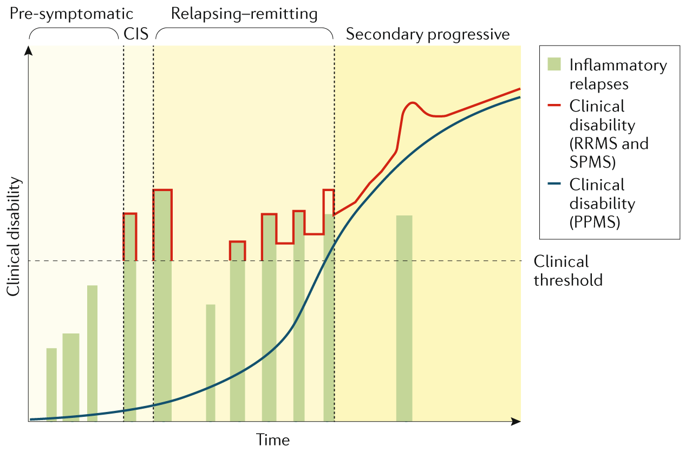Nature Reviews Disease Primers ( IF 76.9 ) Pub Date : 2018-11-08 , DOI: 10.1038/s41572-018-0041-4
Massimo Filippi , Amit Bar-Or , Fredrik Piehl , Paolo Preziosa , Alessandra Solari , Sandra Vukusic , Maria A. Rocca

|
Multiple sclerosis (MS) is the most common chronic inflammatory, demyelinating and neurodegenerative disease of the central nervous system in young adults. This disorder is a heterogeneous, multifactorial, immune-mediated disease that is influenced by both genetic and environmental factors. In most patients, reversible episodes of neurological dysfunction lasting several days or weeks characterize the initial stages of the disease (that is, clinically isolated syndrome and relapsing–remitting MS). Over time, irreversible clinical and cognitive deficits develop. A minority of patients have a progressive disease course from the onset. The pathological hallmark of MS is the formation of demyelinating lesions in the brain and spinal cord, which can be associated with neuro-axonal damage. Focal lesions are thought to be caused by the infiltration of immune cells, including T cells, B cells and myeloid cells, into the central nervous system parenchyma, with associated injury. MS is associated with a substantial burden on society owing to the high cost of the available treatments and poorer employment prospects and job retention for patients and their caregivers.
中文翻译:

多发性硬化症
多发性硬化症(MS)是年轻人中枢神经系统最常见的慢性炎症,脱髓鞘和神经退行性疾病。这种疾病是一种异质的,多因素的,免疫介导的疾病,受遗传和环境因素影响。在大多数患者中,持续数天或数周的可逆性神经功能障碍发作是该疾病初始阶段的特征(即临床分离的综合征和复发缓解型MS)。随着时间的推移,出现不可逆的临床和认知缺陷。少数患者从发病开始就有进行性疾病病程。MS的病理特征是在大脑和脊髓中形成脱髓鞘病变,这可能与神经-轴突损伤有关。人们认为,病灶性病变是由免疫细胞(包括T细胞,B细胞和髓样细胞)浸入中枢神经系统实质并伴有相关损伤引起的。由于现有治疗方法的高昂费用,较差的就业前景以及患者及其护理人员的工作保留,多发性硬化症给社会带来了沉重负担。































 京公网安备 11010802027423号
京公网安备 11010802027423号